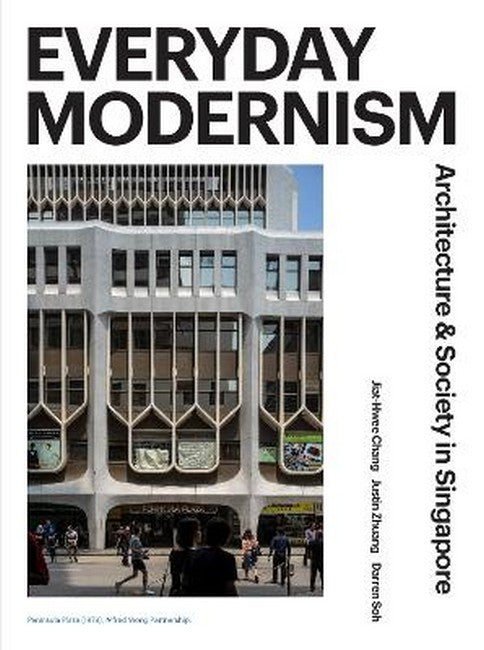Jiat-Hwee Chang is associate professor in the Department of Architecture at National University of Singapore. Justin Zhuang is a writer and researcher based in Singapore, and cofounder of writing studio In Plain Words. Darren Soh is a photographer based in Singapore.
Request Academic Copy
Please copy the ISBN for submitting review copy form
Description
Introduction A. Live 1. Public Housing: The Many Shapes of Home 2. People's Park: Pioneering Integrated Living in a Denser City 3. Futura: The Past and Future of Luxury High-rise Apartments 4. Pandan Valley: The Domestication of "Rural" Singapore 5. Pearl Bank Apartments: How Can We Maintain the High Life? B. Play 6. Cinemas: The Architecture of Advertisement 7. Shopping Centres: Moving Retail from the Streets to the Interior 8. Hotels: Singapore as a Tropical Asian Paradise 9. Lookout Towers: Views of Singapore's Modern Development 10. East Coast Park: "The Singapore Way" to Recreation 11. HDB Playgrounds: Sandboxes for Moulding Model Citizens 12. City Council Pools: Swimming for Health, Leisure and Survival 13. Former Singapore Badminton Hall: Financial Gymnastics and Sporting Venues C. Work 14. Shenton Way: Singapore's Commercial Centre Grows Up! 15. Industrial Spaces: Housing Industrialisation, then a Tech Revolution 16. Jurong Town Hall Road: The Industrial Future as Brutalist 17. Tan Boon Liat Building: A Modern Godown for the Creative Economy D. Travel 18. Market Street Car Park: Up, up... and Who Pays? 19. Pan-Island Expressway: Speeding Up and Spreading Out Modern Life 20. Pedestrian Overhead Bridges: Staying Safe Amidst Accelerated Development 21. Interchanges: The "Nerve Centre" of an Efficient Public Transport E. Connect 22. Public Schools: In Search of a Flexible and Identifiable "Instructional Equipment" 23. Institutes of Higher Education: Systems Planning to Support a Technocratic State 24. Institutional Buildings: A New Monumentality 25. Public Libraries: "Palaces for the People" 26. Community Centres: Modernising the "Central Nervous System" of Singapore 27. Hawker Centres: Regulating Itinerant Individuals into a Social Institution 28. Lucky Plaza: A Mall for the Migrants who Modernised Singapore F. Pray 29. Churches: Bringing God Closer to the Suburbs and the People 30. Cinema-Churches: From a "House of Pictures" to a "House of Prayers" 31. Darul Aman Mosque: A Modern Revival of the Traditional 32. Columbaria: Raising Up the Dead for the Living
"Accessibly written and brimming with historical detail informed by local scholarship and archives, especially newspaper sources, the short entries also reproduce rare photographic or documentary material... Bookending the volume's essays is a striking 100-something page spread of [Darren] Soh's images, printed in full color, in which apartment blocks, former school buildings, cinema complexes, and children's play areas alike are portrayed with an aestheticized monumentality."-- "Journal of Architectural Education" "The book captures the life of Singapore's modernist developments through 32 essays, each covering various typologies, which fills a gap in documentation on them."-- "The Straits Times" "The history of the modern global built environment, a landscape made up of unexceptional, everyday buildings, remains largely untold. Everyday Modernism: Architecture & Society in Singapore makes a notable contribution to this elision in historical knowledge about modernist architecture and urban planning. By underscoring the importance of quotidian encounters with modernist architecture, Everyday Modernism not only illuminates a history of modernism in Southeast Asian architecture, it also poses an important challenge to conventional architectural historiography in underscoring the importance of state institutions in the production of modernist architecture.... [this] is a welcome addition to studies of housing and should be required reading in any course on the history of post-World War II modernist architecture and urban planning."-- "Southeast Asian Studies" "In Everyday Modernism, the authors examine the beginnings of modernization in the city-state, from the rise of heroic skyscrapers, to the spread of utilitarian typologies like multi-story car parks. The title encapsulates not simply the physical environment, but also the social, political, economic and cultural processes of nation building, approaching this by reworking and reframing existing urban theories. Tracing the histories of iconic structures such as People's Park Complex and the National Theatre, the book equally sheds much-needed light on public housing, libraries, community centers, and other buildings that make up the fabric of the city yet are seldom lauded. Instead of referring to these through conventional architectural types, they are divided into six key verbs--live, play, work, connect, travel and pray -to fully illustrate the complex interplay between form and use."-- "Southeast Asia Building" "Most importantly, [the book] shows that modernist architecture in Singapore is not just a collection of beautiful built structures that look nice in photographs but actual places where people eat, stay, live, find, and achieve a better way of life over time... readers can enjoy Darren Soh's incredible photographs, which range from large-scale structures to playground equipment, as well as old images and drawings that illustrate the lifecycle of each built structure." -- "art4d" "Everyday Modernism is the first comprehensive documentation of Singapore's modern built environment. Through a lens of social and architectural histories, the book uncovers the many untold stories of the Southeast Asian city-state's modernization, from the rise of heroic skyscrapers to the spread of utilitarian typologies like the multi-storey car park. It investigates how modernism, through both form and function, radically transformed Singapore and made its inhabitants into modern citizens."-- "Asian Review of Books" "The story of Tan Boon Liat Building is one of 32 essays in Everyday Modernism that gives readers an insight into Singapore's development through its architecture, not only seen through buildings but also in everyday or more mundane structures such as overhead bridges and city council pools. . . . [The essays] make for easy reading and provide context on Singapore's development from post-independence to the 1980s." -- "The Business Times (Singapore)"

